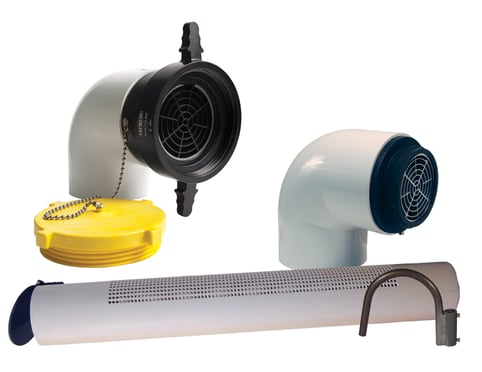Blog Post
Dry Hydrants: An Overview
Aug. 18, 2021

For people who live in rural areas without access to a pressurized fire hydrant system, dry hydrants can be a lifesaver—literally. A dry hydrant allows firefighters to tap a reliable water source like a lake, pond, or stream—to fight a fire without using a traditional fire hydrant.
Photo courtesy of iStock/GomezDavid
The success of extinguishing any fire often hinges on having enough water quickly to win the battle. Without that, you can’t properly fight a blaze. This is particularly true in more remote areas, where there is often a long distance between the water source and the fire, and firefighters are unable to maintain an uninterrupted water supply at the scene. Using a non-pressurized pipe system to draw from a local water source provides a ready means of supplying water to fire engines. “It’s hard to be successful as a fire department if you don’t have water to perform the job,” says Cole Schieke, a product specialist with Dixon. “It’s expensive and not always possible for fire companies to have multiple trucks at a fire scene shuttling water. The ability to tap into these alternative water sources could not only saves lives but money as well.”
The Anatomy of a Dry Hydrant
Photo courtesy of City of Angola, Indiana, USA
Both a 45° and a 90° configuration can be used to install a dry hydrant. One may be a better choice than the other depending upon the terrain at the site location.
A dry hydrant consists of three primary parts: the head or connection where a fire company connects its hoses; the pipe, a permanently installed PVC tube mounted with one end below water level; and a strainer attached at the underwater end of the PVC pipe that works to strain out debris.
When a fire company arrives at the scene, firefighters will vacuum the air out of the system to prime the hydrant. Since lower pressure now exists at the pump intake, atmospheric pressure forces water into the pipe, through the head, hose attachment, and into the pumper truck.
Dry Hydrant Dos and Don’ts
When installing a dry hydrant system, there are several key factors to consider:
1. Water level. When considering a body of water in which to install a dry hydrant, Schieke advises, make sure the absolute water level never dips below 2 feet in depth, and ideally stays at least a constant 4 or 5 feet. “You want to prevent a vortex or whirlpool, which could allow air to enter the pump and cause loss of pump prime,” he says.
2. Body of water size. Because of the amount of water needed to fight a fire Schieke says, you’d want at least 600,000 gallons or a body of water the size of approximately two football fields with a depth exceeding 2 ft. “You should never see a dry hydrant installed in a small stock pond,” he says. “That’s definitely not deep enough, nor large enough.”
3. The tides. If you install a dry hydrant in a river or stream, remember to consult the ebb and flow of daily tides, which could bring water levels below the 2-foot minimum. Also, all bodies of water are subject to drought conditions, so water levels should be monitored closely.
4. Composition of bottom material. For long-term useful hydrant operation, the best composition for the bottom of a lake, stream, or pond is sand, gravel, or rock, or a combination of the three. Watch out for excessive decaying vegetative matter that could clog the suction screen.
5. Protect the connection. A location that is conveniently accessible to fire trucks may also be exposed to accidents from passing vehicles. An impact barrier constructed of partially buried posts may be needed to prevent a vehicle from destroying a dry hydrant in a heavily traveled area. Special markings may be necessary to avoid damage from snowplows.
6. Consult with your local resources. For homeowners, construction firms, or developers who wish to invest in a dry hydrant system for their property, it’s always a good idea to work closely with local fire departments. This is the best way to ensure that hydrant components fit the department's equipment and that the dry hydrant will be accessible to fire trucks. You may also need a permit from your local Department of Natural Resources (DNR) office to install a dry hydrant in a public body of water. If you’d like to install a hydrant on privately owned property, you’ll need permission from the landowner in writing.
Keep an Eye on Things
Dry hydrants require periodic checking, testing, and maintenance. The hydrants should be backflushed at least annually to ensure the line and strainer are clear of debris, silt, and aquatic vegetation. After backflushing, the hydrant should be tested, as part of regular training exercises, for proper operation and maximum flow rate. Records are normally kept for each hydrant.
Other Advantages
In addition to potentially saving lives and reducing water costs, dry hydrants may also save money when it comes to insurance. Insurance companies base their homeowner insurance rates on several factors, one of which is a fire department’s ability to respond quickly and deliver enough water to douse a house fire. Typically, if your property is close to a fire hydrant, your insurance rates will be lower than a property further away. The same applies to dry hydrants. Check with your insurance company to find out if they offer a discount for close proximity to a dry hydrant.
Save More Money
In the U.S. several states, as well as the Federal Emergency Management Agency (FEMA), offer grants for installing dry hydrants in rural areas. Check with your state’s Department of Natural Resources, the federal government’s grants.gov website, or other grant-issuing institutions.
Place an Order with Dixon Dixon provides a diverse line of fire protection products. Our portfolio includes dry hydrants support and backflushing strainers, male adapters, and caps, as well as female adapters and plugs. Other Dixon products used in fire protection include brass and aluminum valves, adapters, nozzles, fire hoses, racks and reels, fire department connections, Storz fittings, and large diameter hoses (LDH) suction hoses. Dixon is a U.S.-based manufacturer supporting our customers with fast delivery from our extensive distribution network including 12 locations across the U.S.
Dixon provides a diverse line of fire protection products. Our portfolio includes dry hydrants support and backflushing strainers, male adapters, and caps, as well as female adapters and plugs. Other Dixon products used in fire protection include brass and aluminum valves, adapters, nozzles, fire hoses, racks and reels, fire department connections, Storz fittings, and large diameter hoses (LDH) suction hoses. Dixon is a U.S.-based manufacturer supporting our customers with fast delivery from our extensive distribution network including 12 locations across the U.S.
For more information about dry hydrants, watch our video.
If you have questions about dry hydrants or our other fire protection products call 877.963.4966 or visit dixonvalve.com
 EU | en
EU | en